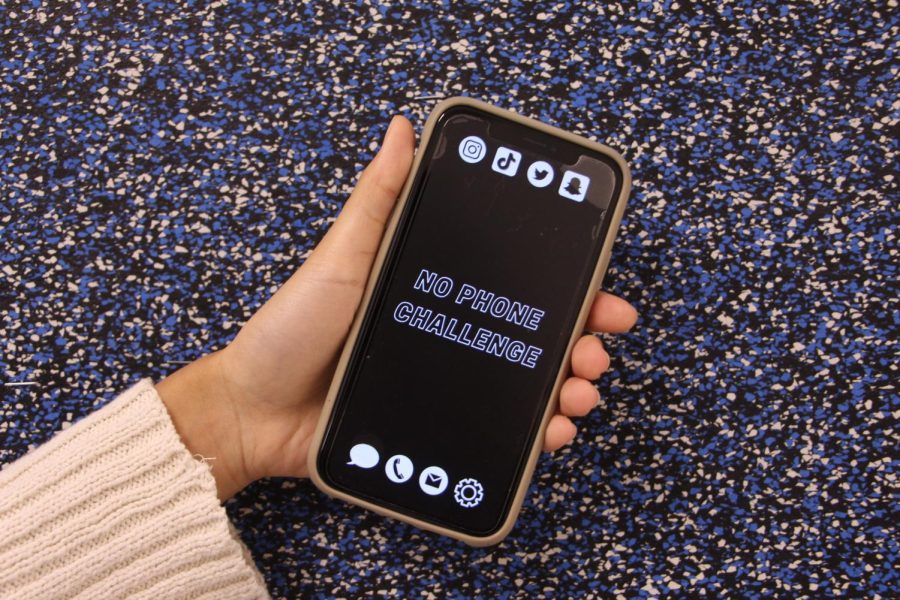No Phone for a Week? Challenge Accepted
September 9, 2022
Teenagers call it an essential. Adults call it an addiction. Phones, or rather time spent on phones, is undoubtedly a subject of controversy. Most teenagers recognize that greater screen time has repercussions, but to what extent? FM Wire staff members Nandini and Tina took on the No Phone Challenge to find out.
On Sunday, Aug. 28, Nandini and Tina shut down their phones and tossed them into oblivion—that is, underneath their beds. That meant no text messages. No social media. No phone calls. All contact with the outside world would occur through email, which meant first announcing the challenge to family and friends.
“When I told my parents, they were kind of weirded out. The first day, my mom came into my room to ask if I had seen an Instagram reel that she sent me, and I had to remind her I was doing the challenge,” Tina said.
Nandini and Tina started on opposite ends of the screen time spectrum: Nandini’s average recreational daily screen time was 35 minutes, whereas Tina’s was over two hours. For Nandini, who grew up with a ban on weekday screen time, limiting technology use had become a habit. Tina, on the other hand, saw a dramatic increase in her screen time after the onset of quarantine. Both nonetheless agreed that their phones were an impulsive distraction, noticeably reducing attention span and memory.
“Even after scrolling for 15-20 minutes, I feel like I can’t remember anything that I saw. Especially when I come home from school, it’s a distraction from doing things that require actual brain power. It’s so much easier to sit and watch a YouTube video than it is to write an essay for history class,” Nandini said.
Day 1 held different challenges for the two girls. Nandini struggled with accommodating the logistics of the challenge, having to email her parents in advance to coordinate a ride after school. By contrast, Tina’s main difficulty lay in breaking her everyday routine.
“I didn’t have a hard time during school, but when I got home it felt really odd not doing what had become habit. When usually I would go on my phone, I was now reading a book or staring at walls…a lot,” she said.
Day 2 proved difficult for Tina because she felt highly anxious for unrelated reasons, but continuing the challenge meant sitting with thoughts instead of escaping them. Nandini felt similarly, hoping to forget about a tough day by reaching for her phone.
“I came home from school and was upset over a bad grade. I wanted to forget about things for a while and scroll on Instagram. Instead, I spent time talking to my parents. It felt good,” she said.
Day 3 was largely uneventful. Self-restraint grew a little easier, and limiting screen time felt more normal.
“I’m realizing that the only actually useful thing I do on my phone is contact people through messages and phone calls. Everything else is just fluff,” Tina said.
For Nandini, Day 4 flew by busily. The lack of free time meant forgetting about her phone, at least for the day.
“I had a history test to study for, and I got right to work as soon as I got home. I didn’t really pay attention to the fact that I hadn’t had any screen time yet to unwind. I guess this no phone thing is really catching on,” she said.
On Day 5, the Friday before Labor Day weekend, both Nandini and Tina chose to spend their free time with family. The challenge persisted through the entire week; neither of the two had given in. Though the spirit of the challenge may have reduced temptation, how much of an impact did no phones have after the fact?
“I got a taste of what it meant to sit with boredom. It’s easy to default to absent-minded screen time, but I’ve realized that I need to take time to be in tune with my thoughts, without social media running in the back of my mind,” Tina said.
“Looking back on this week, I’m glad that I agreed to this challenge. Sometimes it’s okay to have little gaps of inactivity throughout your day. It’s important to give your mind and body a break,” Nandini said.


